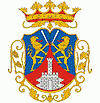Szigetvár
 |
The town's fortress was the setting of the Siege of Szigetvár in 1566. It was a sanjak centre at first in Budin Province (1566–1601), later in Kanije Province (1601–1689).
The former Andrássy Palace is next to them. Some other monuments in the town date back to Ottoman times. Two years after the siege, the mosque of Ali Pasha was built, later – in 1788 – to be transformed into a Christian church: the Roman Catholic parish church. The two minarets, as well as the windows and niches with ogee arches indicate its original function. The Turkish House of red raw brick walls and interlaced steel window grills in Bástya Street was originally destined to be a caravanserai. The two holy-water basins of the Franciscan Church were made of Turkish washbasins. The carved main altar of the Baroque Church is another sight to see. In 1966, on the 400th anniversary of the siege, Szigetvár regained its old rank of a chartered ancient city. Development began to gather speed. Today it has a population of 12,000. In October 2011, the city received the title Civitas Invicta from the Hungarian Parliament.
In 1994, the Hungarian-Turkish Friendship Park (Magyar-Török Barátság Park) was established as a public park, dedicated in memorial to the Battle of Szigetvár.
Archaeological digs conducted by the University of Pécs starting in 2016 revealed the tomb of Sultan Suleiman the Magnificent in the nearby destroyed settlement of Turbék.
Map - Szigetvár
Map
Country - Hungary
 |
 |
| Flag of Hungary | |
The territory of present-day Hungary has for centuries been a crossroads for various peoples, including Celts, Romans, Germanic tribes, Huns, West Slavs and the Avars. The foundation of the Hungarian state was established in the late 9th century AD with the conquest of the Carpathian Basin by Hungarian grand prince Árpád. His great-grandson Stephen I ascended the throne in 1000, converting his realm to a Christian kingdom. By the 12th century, Hungary became a regional power, reaching its cultural and political height in the 15th century. Following the Battle of Mohács in 1526, it was partially occupied by the Ottoman Empire (1541–1699). Hungary came under Habsburg rule at the turn of the 18th century, later joining with the Austrian Empire to form Austria-Hungary, a major power into the early 20th century.
Currency / Language
| ISO | Currency | Symbol | Significant figures |
|---|---|---|---|
| HUF | Hungarian forint | Ft | 2 |
| ISO | Language |
|---|---|
| HU | Hungarian language |















